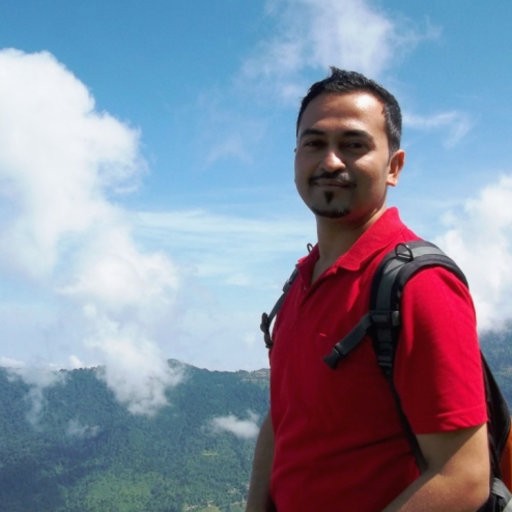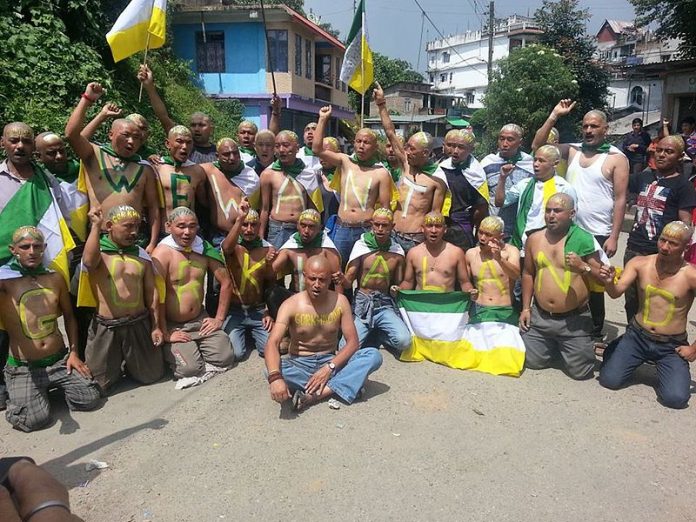The quest of the native Nepali speaking people across South Asia to cartographically chart their emic self-defined identity in a map called Gorkhaland has compounded scholarly engagements in multitudes. However, the notion of community conceptualization of ‘insiders’ and ‘outsiders’ and the angst towards those perceived as the ‘Others’ has seldom found extensive investigation. The 1980s were turbulent times in Gorkhaland Chuttei Rajya Andolan (separate state of Gorkhaland movement) in the geopolitical space of Darjeeling. The 1986 Gorkhaland movement popularly known as the Chiyasi ko Andolan embeds in the inherited collective memory of the region strong imaginaries of violence, hurt, and angst. For both the insiders and the outsiders remembering the Chiyasi ko Andolan entails engagements with exasperations of violence, loss, hurt, discomfort and erasures. The discussion in this article would glean into the notion of the ‘Bahira ko Manche’ (socio-cultural-political outsiders/‘non-members’), and ‘Bhitra ko Manche’ (socio-cultural-political insiders/‘members’) among the Gorkhas of Darjeeling and bring forth the sanitization and wedging of the lines between social-political insiders and outsiders and their negotiations with remembering, silence and forgetting.
The Others: A Postmortem
Politically, ‘identities’ are the consequence of how power is organized; and how it defines the parameters of the political community, telling us who is included and who is excluded; it also differentiates the bounded political community internally. A yearning strongly channels the notion of citizenship/domicile/residency in the region for a definition of a native, immigrant, and insider to prove original inhabitance. In this process of identification, we exclude the other from our shared space of imagination or existence, consciously or unconsciously, by outlining the politics of inclusions and exclusions. And this becomes intrinsically interwoven within the sub-text of ‘Insider-Outsider’ Politics.
The category of the ‘Others’/‘Outsiders’ later inmigrants or non-native Nepali speaking population as conceived by the Gorkha/Gorkhey is conveniently bracketed and confined to the contentious tag of the ‘Bahira ko Manche.’ The ‘Bahira ko Manche’ as a fuzzy tag includes the ‘Madheshiya.’ In the case of Darjeeling Hills, the tag ‘Madheshiya’/ ‘Madheshi’can broadly include the ‘Bengali,’ the ‘Marwari,’ the ‘Bihari,’ the ‘Punjabi’ etc. Among the Nepali speaking community in India especially in the North Bengal region, the tag ‘Madheshi’ is used to refer to any plains person more specifically to the Hindi speaking persons identifiably the Bihari. In the North East, the term ‘Madheshi’ has very limited usage and the plains people are referred to as ‘Thal ko manche’ (flat land people). The category of the ‘Others’ is fuzzy. In broader context also incorporates the Santhal/Adivasi (most now clubbed as the ‘Tea tribes’), and the Tibetan (including those spread across the town and those at the Self Help Centre) locally referred to as the ‘Bhotey’ seen as unwanted intruders infringing on local resources and eventually controlling the local economy thereby depriving the Nepali/Gorkha the benefits of ‘their land’ etc. It encapsulates those groups or ethnic communities/minorities that maintain cultural, linguistic distinctiveness or exclusiveness all those that do not necessarily share the imagined rootedness to the ‘Bir Gorkha’ (brave Gorkha).
Being Local, ‘Bahira ko Manche’ and ‘Bhitra ko Manche’
The term ‘local’ during the colonial times conveyed derogatoriness. Through the 1950s-1970s the term ‘local’ conjured the uncivilised, unpolished, rustic side of the native gentry in the colonial bastion of Darjeeling. For instance, the English educated pupils (native or otherwise) of the missionary boarding schools were exhorted to be ‘British-like’ and discouraged to act like locals. In everyday parlance ‘local’ refers to the traditional alcoholic beverage such as jaanr-rakshi-teen pani, while the ‘foreign’ refers to presumably sophisticated foreign alcoholic beverages -whiskey, wine etc. ‘Being local’ thus at a certain historical time of Darjeeling like elsewhere in South Asia signified what was at the margin, muddled in class, race issues. With the ‘Chiyasi ko Andolan’ the ‘local’ jumped the scale to the centre, with new-found vigoured agency. The lines between the ‘local’ and the ‘non-local’ and the ‘Bhitra ko Manche’ and the‘Bahira ko Manche’ are neatly chalked by the Samaj (‘localized vigilant residential communities’ or rudimentary community known as Gaon Samaj) and time shifting political affiliates. While in the case of the ‘local’ and the ‘non-local’, communities could and do contest claims to be ‘local’ based on ‘time bound’ (lit.,‘Palo’ in Nepali) rootedness to Darjeeling.
Communities and individuals have claimed to be ‘local’ based on linguistic proficiency, marriage, gastronomical behaviour, political affiliations/inclinations and the like with degrees of success. In the case of the notion of ‘Bahira ko Manche’ and ‘Bhitra ko Manche’ such strategies and claims remain unnegotiatable. Conversations surrounding the negotiations and techniques of transgressions between these polar categories are summed up aptly by one respondent who mentioned: ‘one can be accepted as a ‘local’ through marital ties but never become a ‘Bhitra ko Manche.’ Marrying a Gorkha woman is not a ticket to become a ‘Bhitra ko Manche’; it is merely a card/pass to be accepted as a ‘Juwai’ (lit., ‘son-in-law’, in Nepali), a local in some degrees at select spaces.
Native Nepali speaking communities from elsewhere though accepted as Gorkhas by the Darjeelingeys remain ‘Bahira ko Manche’ for all purpose. The ‘Bhitra ko Manche’ is a coveted realm reserved and inherited only by the Darjeelingey (the ‘son of the soil’, the Bhoomiputra).’ The ‘Bhitra ko Manche’ is a complex coveted space-tied construct and hems out those not belonging, and operates in situated variations across the hills of Darjeeling, Kurseong and Kalimpong. The inherited proximity to centres of power and multi-braided authority in Darjeeling town compounds the hierarchies within the notion of ‘Bhitra ko Manche.’ One respondent mentioned that ‘the Darjeelingeys reserve the space of the ‘Bhitra ko Manche’ only for themselves. The Darjeelingeys as ‘Bhitra ko Manche’ while drawing the blueprint of the narrative of Gorkhaland fine tune the variegations within the notion of socio-political ‘Insiders’. The people of Darjeeling are the ‘Janta’ (citizens), those of Kurseong and Mirik are ascribed the status of the ‘Janti’ (lit., guests of the groom in a Nepali Hindu marriage); and those from Kalimpong the ‘Jantu’ (sub-human, uncivilised, uncouth, intellectually inferior, agrarian people).’
As elsewhere in India too we find that the construct of the ‘Gorkha’ is vexed and does not stand the test of homogeneity. Though the Gorkhaland movement(s) in its different phases has called for a collective solidarity, experience shows that the Gorkha is variegated. For instance, Mr. Chhetri (name changed), Mr. Subba (name changed), and many others from different parts of the North East of India who, post-retirement, shifted base to Darjeeling (District) found that they were treated as second citizens and scorned as ‘recent arrivals’ and often subjected to the Bahira-ko-Manche (outsiders) treatment. In fact, one of my respondent mentioned that Gorkhaland and Gorkha identity is assumed to be the badge of only the ‘Darjeelingwalas’, the rest of the Nepali-speaking people are mere pawns for mobilising the cause of the Gorkhaland movement. The contemporary debates around the Lok Sabha Elections 2019 in the public sphere in Darjeeling on Bhoomiputra (‘Sons of Soil’) versus Gorkheyputra (‘Son of Gorkha’) in connection with the candidature of Shriman Amar Singh Rai (local resident of the hills belonging to the OBC (Other Backward Caste)) supported by the TMC-backed GJMM (Binay Tamang, Anik Thapa faction) and that of Shriman Raju Bista (a Gorkha from Manipur in Northeast India, belonging to the Khas-Chhetri) supported by the BJP-led GJMM (Bimal Gurung), the GNLF (Subash Ghisingh’s Gorkha National Liberation Front) and other political parties from the hills during the Lok Sabha Elections 2019 reaffirms the internal tensions and murmurings within the category ‘Gorkha’ and substantiates the perceptual notions of Bahira ko Manche and Bhitra ko Manche in Darjeeling.
Sanitizing the Hills: Remembering, silence and forgetting
Subash Ghisingh, the GNLF supremo during the Chiyasi ko Andolan through his speeches and writings wedged distinction between the two identities- ‘Nepali’ and ‘Gorkhali’; and provided a first-hand definition of a Gorkha/ Gorkhali in the Indian context. The definition was highly exclusive and advanced a notion of ‘genuine peoplehood’ around the presumed historic connectivities; notions of a martial race (‘Bir Gorkha’) and rootedness to the ‘Mato’ (land). The territorial space of Darjeeling was elevated to the coveted sacred space for the Gorkha cartographic expression that needed to be protected and sanitized from assimilative-appropriative influences of the outsiders. Ousting the ‘Bahira ko Manche’ and cleansing the ‘Mato’ (the motherland) became the ethnolinguistic mission, following which outsiders namely Bengalis were selectively targeted and ousted from Darjeeling. Many were eliminated, and very few had the option for distress sale of their ‘Kothis’ (cottages), a good number hurriedly left everything behind. Pakhrin daju (Personal Interview, Darjeeling, 2014) mentioned: ‘during the Chiyasi ko Andolan the Bengali families in Kalimpong and Darjeeling were threatened and forced to sell their properties by the goondas aligned to the GNLF. The Gorkhaland movement of Ghisingh was a violent one. The objective was to take control of prime properties belonging to outsiders and bring a kind of distributive justice in terms of control of the property in the hands of Bhitra ko Manche.’ Pakhrin further mentioned: ‘that the lower division clerks and office bearers in government offices took the opportunity to buy the property in a distress sale. These clerks and office bearers were known to be highly corrupt and monied persons’.
In a few cases, the Bengali owners left the keys of the ‘Kothis’ to the charge of the local caretakers with the assurance that they would ‘be back once things get normalized.’ One such caretaker, Subba daju (Personal Interview, Kalimpong, 2014), and family still take care of the property but have not heard from the Bengali family since then. Mr. Lohagun (Personal Interview, Darjeeling, 2014), another respondent, mentioned that he heard his older sister repeat stories of 1986 and horrors of the slaughter of a Bengali tea garden manager and his family (name and place withheld). The vindictive killings and arsons of properties belonging to the select Bengali community have not been documented and thus silenced in the writings on Gorkhaland. The Bengali families who fled from the hills have maintained a hidden silence and those contacted preferred not to remember. ‘The victimization and targeting by the GNLF and its fringe outfits were not restricted only to the ‘Bahira ko Manche’ (outsiders). There was a selective targeting of even those ‘Bhitra ko Manche’ (insiders/local Manche) working in state government offices and those suspected of being non-supportive of Ghisingh’s calls,’ mentions Pakhrin daju.
Forgetting remains a challenge, the inter-generational memories among the ‘Bhitra ko Manche’ of the violence of ‘Chiyasi ko Andolan’ finds mention in conversational expressions such as ‘chai inchi ghatai dinchu’ (‘will reduce 6 inches,’ i.e., threat to behead someone). The display of decapitated bodies on bamboo poles or trees was a regular feature of the Chiyasi ko Andolan. The Bir Gorkha construct was webbed in acts of inscrutable violence and display of military masculinities.
In this drive to rewrite a history from a Gorkha spectacle, and sanitize a colonial space, a deliberate erasure of rootedness of the autochthonous- the Lepchas, and the connectedness of the ‘Bhotey’ occurs. The innocuous erasures drive forward an important phenomenon of ‘same-same but different’ that is the Lephca rootedness succumbs to the Gorkha hegemony differently than those bracketed in the Bahira ko Manche. The Lepchas are tactfully elevated to ‘honourable denizens’ as fence sitters, and the ‘Bhotey’ as the ‘over-staying guests’ in the scheme of arrangements while the Bahira ko Manche are left predisposed to vulnerability. Here, we find an interesting case of the Gorkhas as victims elsewhere through the 1980s in Northeast of India, and the neighbouring country (Bhutan) becoming killers and inflictors of violence in their claimed territorial homeland. This comes almost replicative of the Rwandan case, as documented in Mahmood Mamdani’s ‘When Victims Become Killers.’

The author is an Assistant Professor, Department of Political Science & Political Studies, Netaji Institute for Asian Studies, Kolkata; and member Mahanirban Calcutta Research Group (MCRG), Kolkata. Also Visiting Faculty, Department of South and South East Asian Studies (SSEAS), University of Calcutta.


